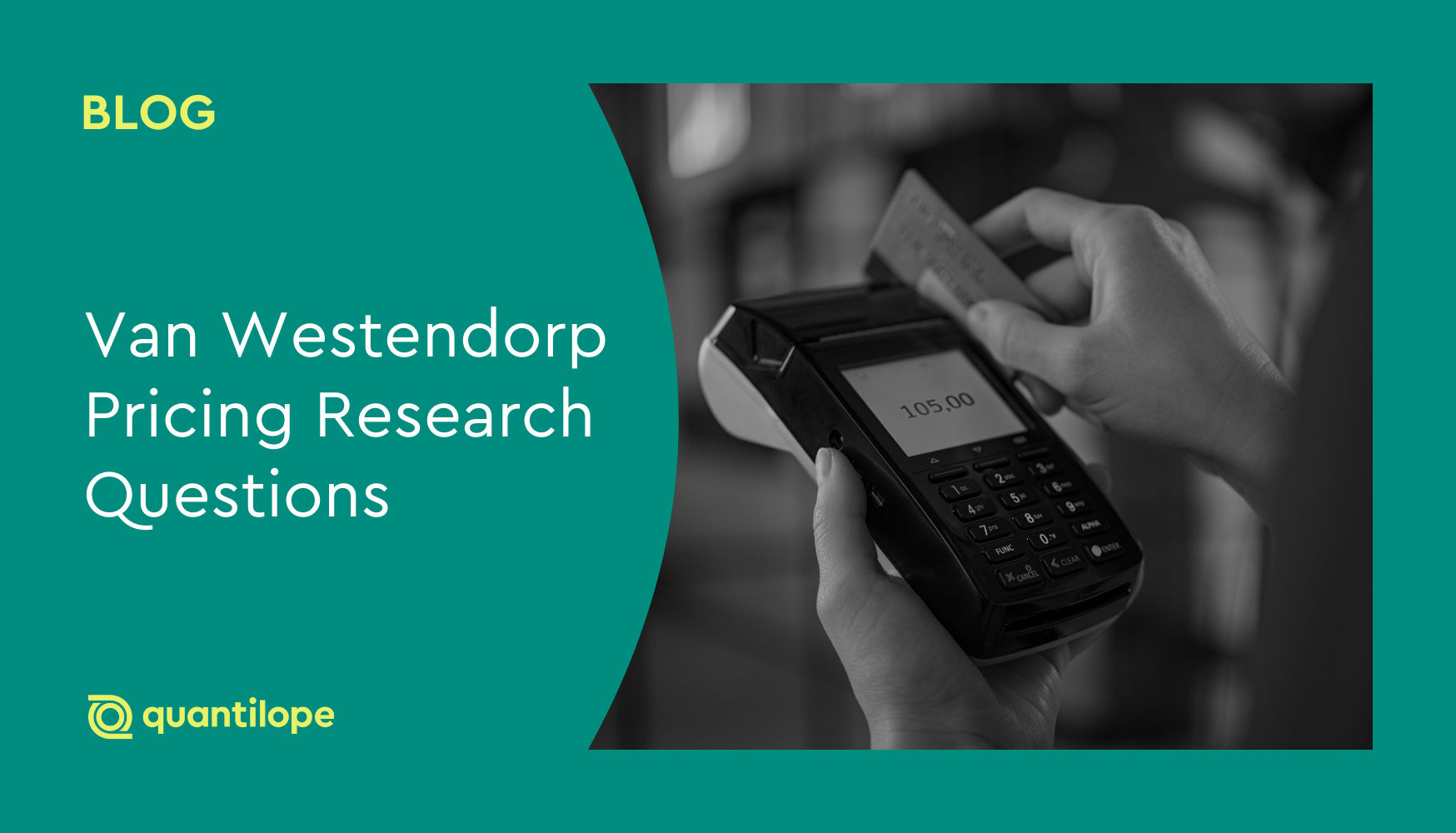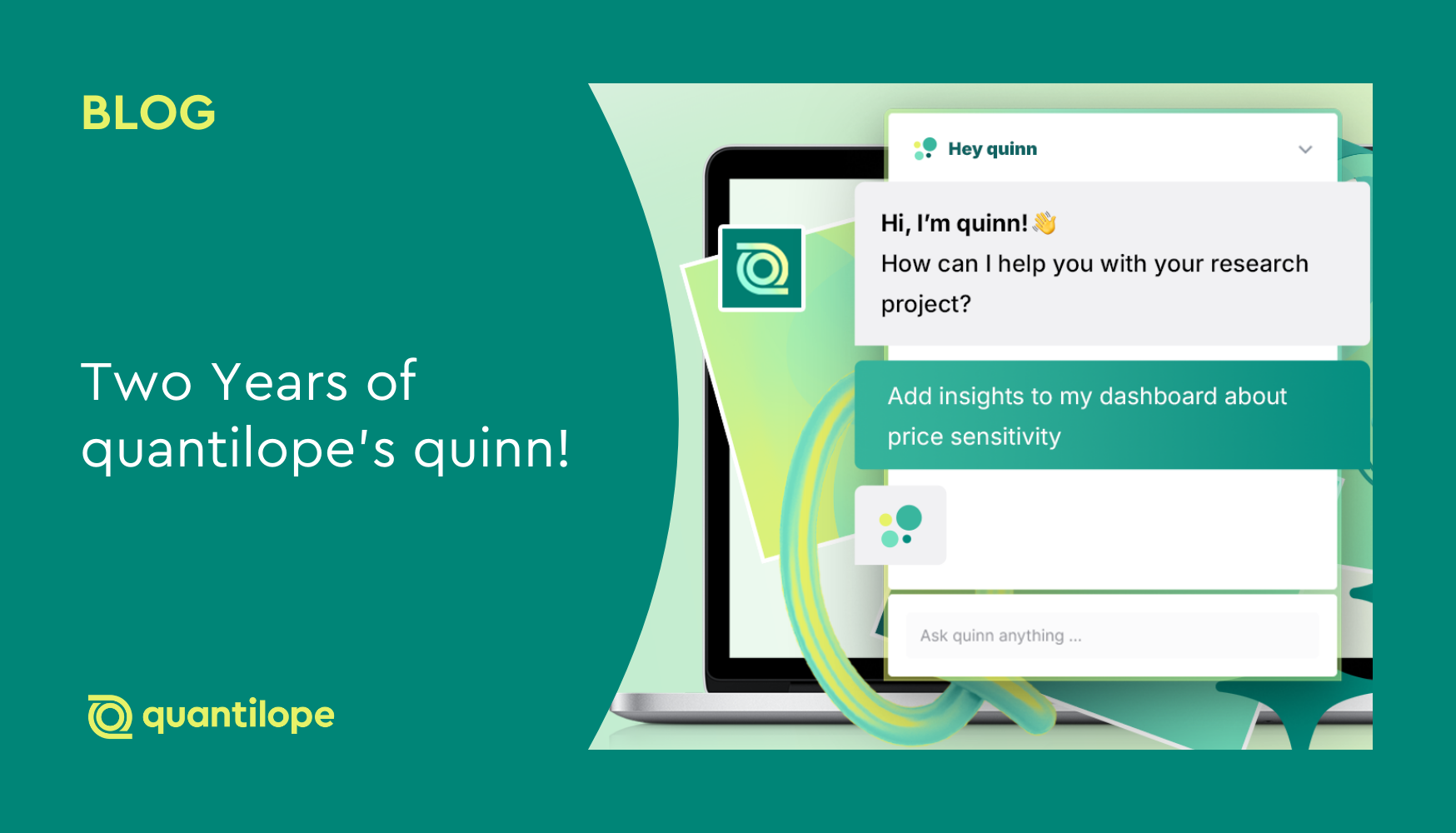The Van Westendorp Price Sensitivity Meter (PSM)* is a trusted advanced method in market research that helps businesses make informed pricing decisions for a new product or make price changes to an existing product.
The method helps brands understand consumer perceptions of their product/service pricing (and related value) by using a set of four carefully crafted pricing research questions. These four questions - which we’ll expand on below, determine the optimal price points for your offerings to maximize both profit and customer satisfaction.
*As a note - the names ‘Van Westendorp’ and ‘Price Sensitivity Meter (PSM)’ are often used in isolation, interchangeably; the name originates from Dutch economist, Peter Van Westendorp.
Table of Contents:
- What are the four main Van Westendorp Price Sensitivity Meter questions?
- How to set up effective Van Westendorp questions in surveys
- How to analyze Van Westendorp survey responses
- How quantilope empowers your Van Westendorp survey capabilities
What are the four main Van Westendorp Price Sensitivity Meter questions?
A Van Westendorp pricing model is rooted in four fundamental questions that explore different aspects of consumers’ price perceptions:
1. What price is so expensive that you would not purchase the product/service? (Too Expensive)
This question tests the upper limit of your pricing strategy. It helps you pinpoint the price at which customers begin to perceive your product as overpriced and not worth their investment. By identifying this threshold, you can ensure that your prices remain within the realm of what your target audience considers reasonable.
2. What price is so low that you would question the quality of the product/service? (Too Cheap)
Conversely, this question explores the lower boundary of acceptable pricing. By asking respondents to identify a price that seems too good to be true, you can gain valuable insights into the perceived relationship between price and quality. This ensures you avoid pricing your products too low, which could inadvertently undermine perceptions of quality and value.
3. What price is starting to get expensive but you would still purchase the product/service? (Expensive/High Side)
This question probes the upper end of what’s considered the ‘acceptable price range’. It helps you determine the price point at which customers begin to hesitate, though they would still consider buying the product. Understanding this threshold is crucial for fine-tuning your pricing strategy to maximize profits while maintaining a healthy sales volume.
4. What price is considered a bargain/great buy for the product/service? (Cheap/Good Value)
This question aims to identify the lower end of the ‘acceptable price range’. By asking respondents to pinpoint a price that they perceive as a steal, you can gauge their expectations for value and affordability. Armed with this information, you can set a price that not only attracts customers but also reinforces the perception that your brand/product offers excellent value for money.
Back to Table of Contents
How to set up an effective Van Westendorp survey
Many online survey platforms (like quantilope) offer survey templates and pre-built methods to drag and drop into your survey to ensure a smooth advanced method setup. However, below are a few best practices to still keep in mind when building your PSM/Van Westendorp study.
Set the stage:
Before diving into the four main PSM questions, clearly outline the product your respondents will be responding to. This helps respondents visualize what they're evaluating and provides valuable context to guide their price sensitivity.
Choose the right platform/tool:
If you're not using an automated platform like quantilope, be sure to select a survey tool that allows you to easily implement open-ended numerical response fields. This is integral to the PSM method, allowing respondents to input their price points directly, providing the most accurate data (rather than having them select from a pre-defined list).
Keep respondents in mind:
Pay close attention to the wording of your questions, ensuring clarity and conciseness so respondents know exactly what’s being asked. Also make sure your PSM survey easy to navigate and visually appealing to enhance the respondent experience.
Consider incentives:
For your Van Westendorp study, you might even consider offering respondents incentives such as discounts or gift cards to encourage them to participate with high-quality feedback. This is something to consider for really any advanced method or U&A survey you choose to run.
Back to Table of Contents
How to analyze Van Westendorp survey responses
Once you've collected responses for your pricing study, it's time to start the Van Westendorp analysis. Analyze your survey data to extract valuable pricing insights, including an ideal price for your product or service.
A standard PSM output will provide an intuitive visual that considers each of the four main questions you incorporated into your survey. It will display the optimal price point, point of marginal cheapness (PMC)/lower price limit, the point of marginal expensiveness (PME)/upper price limit, the indifference price point (IPP), and the range of acceptable pricing (between the lower and upper price limits). These different metrics help brands explore the “wiggle room” that they can often play within.
Below is an example of what this pricing method output will look like:
How quantilope empowers your Van Westendorp survey capabilities
With quantilope, you don’t need decades of experience in the market research industry to leverage complex advanced methodologies like a Van Westendorp model. Simply select the method from the platform’s dropdown of over a dozen advanced methods (including MaxDiff, TURF, Conjoint, and so on), customize it however you wish, connect any panel of your choice, launch your survey, and monitor results in real-time with direct access to the fielding and reporting tab.
As data is available, toggle between different chart visualizations and cut your PSM data by any combination of demographics or subgroups.
With quantilope, you can:
-
Tailor your advanced method surveys: Create Van Westendorp surveys that are perfectly aligned with your specific product, ensuring that you gather the most relevant data (but without heavy manual lifting for customizations). All questions and advanced methods within quantilope's platform are fully customizable, with the option to add your own colors, images, or logos.
-
Reach the right audience: Enjoy a panel agnostic platform experience to connect to any respondents you wish. When you go after the right consumers that accurately reflect your target audience (i.e. current or potential customers), their feedback acts as validation to your real-world pricing decisions.
-
Make data-driven decisions: Leverage intuitive, automated PSM visualizations to analyze your pricing survey results, identify optimal price points, and make informed pricing decisions that align with consumers’ willingness to pay. This is much easier than combing through an excel file with numbers and percentages that often leave you cross-eyed.
-
Combine a PSM with other advanced methods: quantilope users have their choice of over a dozen advanced methods to leverage in their studies. Combine a PSM with other methods that relate to your business need - such as a MaxDiff to determine product preferences or a TURF to determine product reach.
- Iterate as needed: Pricing is rarely a one-time event. quantilope makes it easy to continuously gather feedback and refine your pricing strategy based on market trends and consumer preferences. Simply add a new wave to your PSM study and recapture respondent data whenever needed.
By harnessing the power of quantilope's automated platform technology, you can unlock valuable insights into your customers' pricing preferences, refine your pricing strategy, and ultimately drive greater success in the marketplace.
To learn more about pricing research and the PSM methodology, get in touch below!





.png)